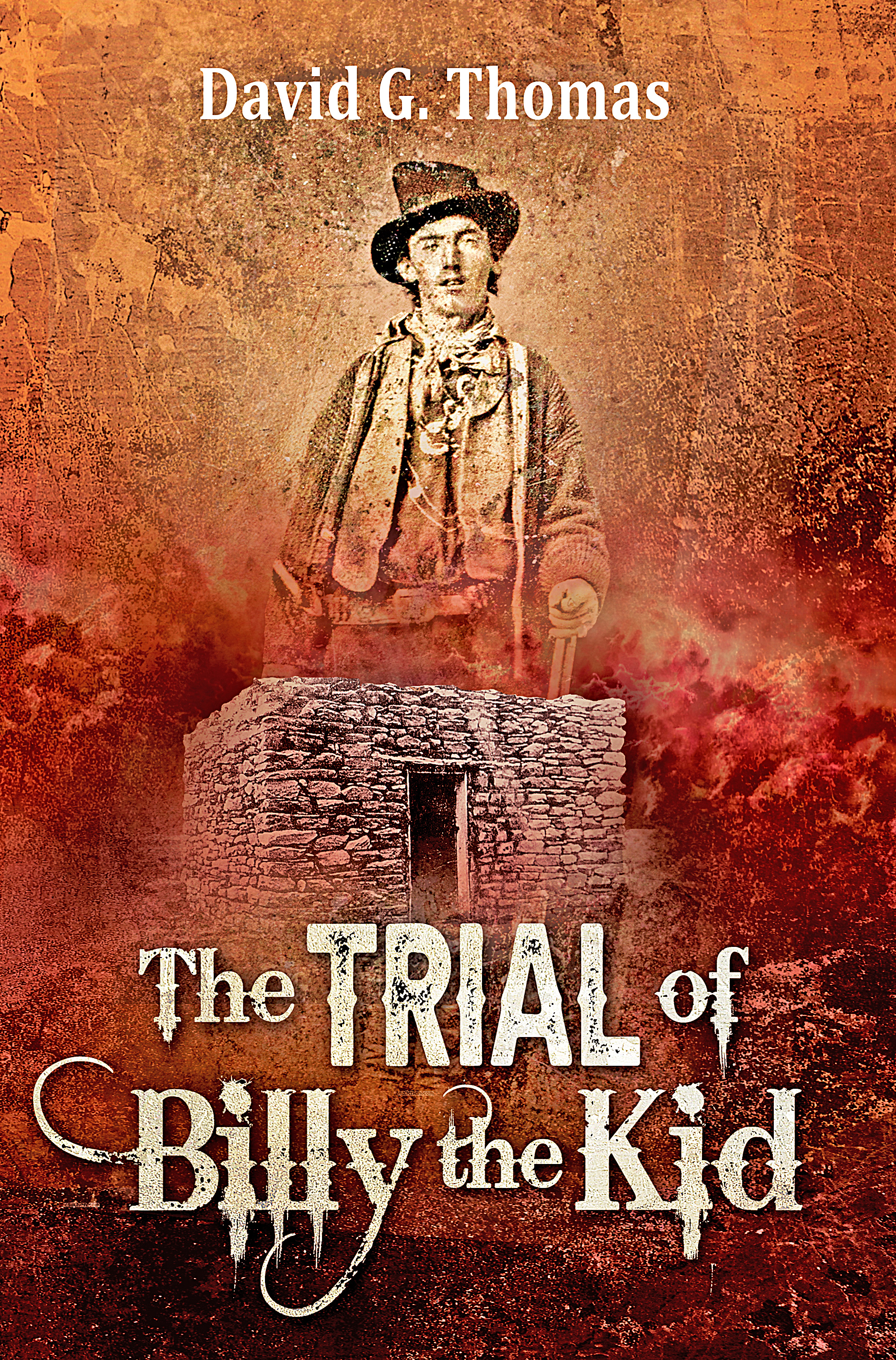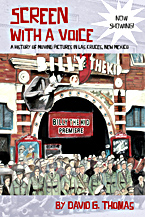Archive for the 'History' Category
Tuesday, September 4th, 2012
La Cueva – Hermit’s Cave
La Cueva (“the cave”) is the name of a rock formation in the foothills of the Organ Mountains in the Dripping Springs Natural Area. You can see it here:
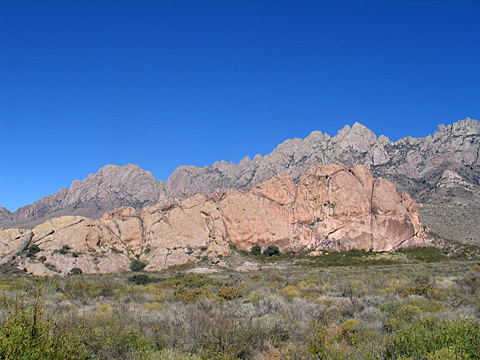
At the center of the photo, where you see the two trees, is the cave that gives the formation its name. You can see the entrance here:

Once you enter the cave, you see:

The cave has been used as a shelter by humans for at least 5,000 years. You can easily see the blackened ceiling caused by innumerable fires:

Also inside the cave a Parks Service plaque giving information on the most famous occupant of the cave, the Hermit de Agostini. Like almost all the information published about the Hermit, this plaque is full of incorrect facts.

His birth name was Giovanni Maria de Agostini and he was born in 1801 at Sizzano, Piedmont, Italy (not Lombardy as other sources say). After he began his travels and on his passport, he called himself Juan Maria d’Augustine. Physically, he was short, had brown eyes and a long face.
He come from a fairly well-off family and received a formal education, learning Latin, French, and studying theology.
In his early-twenties he began his life as a wanderer, visiting religious sites in Italy, France, and Spain. In 1838 he took the rule of Saint Anthony the Abbot – a decision to lead a Monastic life of poverty and the most austere practices of virtue. Shortly thereafter, he departed Europe for the New World, arriving by boat at Caracas, Venezuela. He was 38 years old.
In South and Central America he traveled in Venezuela, Peru, Brazil, Argentina, Chile, Bolivia, Panama, Guatemala, and Mexico.
In 1861 he left Mexico for Cuba, then New York City. He walked from New York City to Montreal, Canada. From Canada he went to St. Louis, Missouri, then Westport, Missouri, then Council Grove, Kansas. Except when he took boats, he always traveled by foot.
The story on the Parks Service plaque is more or less correct about how he got to Mesilla, after spending several years in Las Vegas, New Mexico.
The reason for his murder is unclear. The motive was clearly not robbery because his large silver cross, silver rosary, and several other items of silver jewelry were not taken. A local priest was indicted for his murder but never tried.
Related posts:
New Book on the Hermit of La Cueva
Hiking Dripping Springs – Part 1
Hiking Dripping Springs – Part 2
Hiking Dripping Springs – Part 3
Dripping Springs – Green, Green, Green!
Tags: Las Cruces, Organ Mountains, Hiking, History, Dripping Springs, Chihuahuan Desert
Monday, March 5th, 2012
Hike to Bishop’s Cap Cave
Bishop’s Cap Peak is located at the southern end of the Organ Mountains. It was named because it looks something like a Bishop’s Cap — or so the early namers thought. It is easily seen on the east side of Highway I-25 when driving between Las Cruces, NM and El Paso, Tx.


Bishop’s Cap cave is located on the western side of the peak, about one-fifth of the distance to the summit. The eastern side of the mountain is off-limits. A power line access road traverses the western side of the peak. At the point at which you can see the mouth of the cave, there is a short spur that climbs about 150 feet toward the mountain.

The point where you begin the ascent is marked on the map above (32.18698 -106.61020). You can see the power line road and spur in the satellite image below.
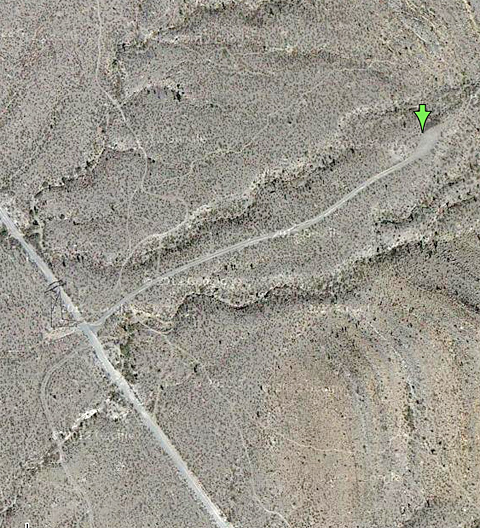
The cave as it appears from the road is shown below.

I rate the hike to the cave fairly difficult. There is no path, it’s rocky, and it would be easy to get hurt. Don’t climb alone, and if you are climbing during snake season, be cautious.
The cave mouth (click for larger image):
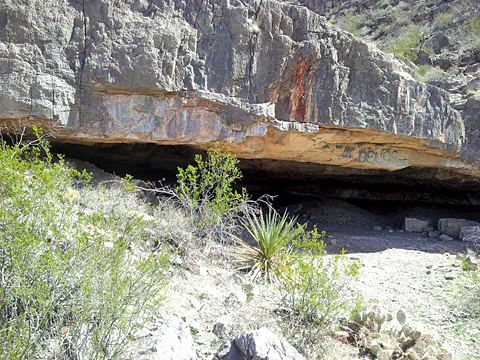
Some images of the cave (click for larger image):
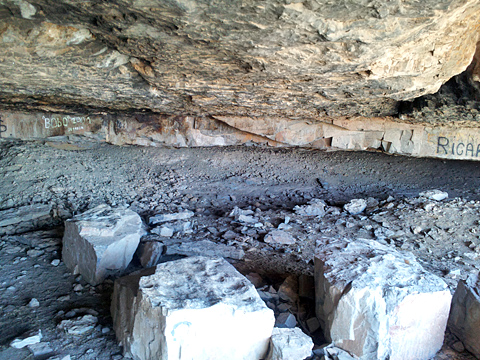


The view from the cave (click for larger image):

See also:
Lightning Strikes Bishop’s Cap
Mine House Spring – Hayner Mine
Mine House Spring – Hayner Mine – The Video
Visit to Apache Wells
Hiking Dripping Springs – Part 1
Sunday, November 13th, 2011
The Electric Light
Every day some new suggestion is made as to the probable use of electricity. A San Francisco professor thinks the time is coming when swamps and sewers will be deprived of their unwholesomeness by strokes of lightning, or, in other words, by electric currents that will kill the germs and spores that communicate disease to the human system. This is based upon the germ theory of disease, which is to the effect that malarial and other foul air contagions are due to animalcule, or infusoria, which multiply in the victim’s body after inoculation. But would it not be a miracle if all atmospheres were rendered wholesome by electrical discharges? The electric light has made one change in cities which may lead to important results. It has enabled buildings and other public works to be constructed at night as well as day. Laborers are employed in eight and twelve hour shifts, and edifices are completed in less than half the time required when only day work could be employed. In summer laborers prefer to work at night. Scientists tell us, as yet we only dimly appreciate the marvelous changes that will be wrought by electricity in human conditions.
Rio Grande Republican, February 18, 1882 (Newspaper)
See also:
First Electric Light in New Mexico
Tags: History, Electricity.
Saturday, August 13th, 2011
First Electric Light in New Mexico
The following advertisement from the June 23rd, 1881 Las Vegas Optic newspaper probably documents the VERY FIRST appearance of electric light in New Mexico.

Regarding the electric light shown in the illustration, the advertisement says:
“All under the most perfect sun-eclipsing ELECTRIC LIGHTS, which are exclusively used to illuminate the VAST METROPOLIS OF EXHIBITION TENTS.”
William Washington Cole, who began his circus in 1871, promoted new technology — “marvels” — in his expositions along with traditional circus acts. The electric light advertised here would have been a Brush Arc Light, which American inventor Charles F. Brush began selling commercially in 1879. Brush had invented the first modern electric dynamo in 1876. One or more of Brush’s dynamos, powered by a steam engine, would have powered Cole’s electric arc lights.
Electric arc lights were quickly shown to be much cheaper than gas, the prevailing technology, and to provide more light. By 1881, Brush had sold over 6,000 arc lights, including the following:
- 800 lights in rolling mills, steel works, shops, etc.
- 1,240 lights in woolen, cotton, linen, silk, and other factories
- 425 lights in large stores, hotels, churches, etc.
- 250 lights in parks, docks, and summer resorts
- 275 lights in railroad depots and shops
- 130 lights in mines, smelting works, etc.
- 380 lights in factories and establishments of various kinds
- 1,500 lights in lighting stations, for city lighting, etc.
- 1,200 lights in England and other foreign countries.
Thomas Edison invented his incandescent light bulb in 1879 which would replace fairly quickly the arc light.
Note that the word “electric” in the advertisement is written with “lightning” characters, a typographic convention evidently already established in 1881.
See also:
Tags: History, Electric Arc Lights, Charles F. Brush, W. W. Cole Circus
Sunday, November 15th, 2009
Visit to Apache Wells
The site known as Apache Wells is located north of Hwy 10, about mid-way between Las Cruces and Deming. About one mile north of Apache Wells is the old route of the Butterfield Overland Stage. The Apache Wells site is marked here:
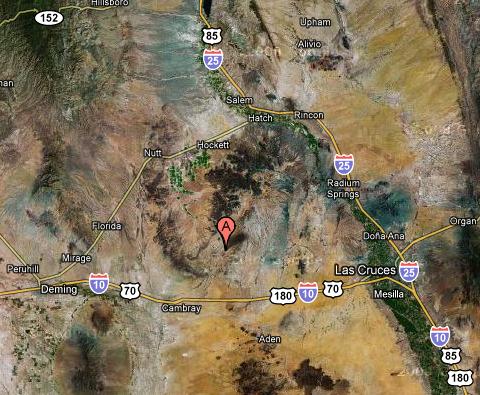
As a source of water, the site was used by Native Americans and later visitors and settlers.
A scratched stone at the location memorializes the killing of Jon Faulkner in 1894. It is known that this stone is not at its original location, which is presumed to be nearby, so it does not mark an actual grave site. A search of various sources reveals no information about the killing of a Jon (or more likely John) Faulkner in 1894 (anyone know more?).

At the top of the stone is scratched “MAID 29 DE 96,” i. e., made 29 December 1896.
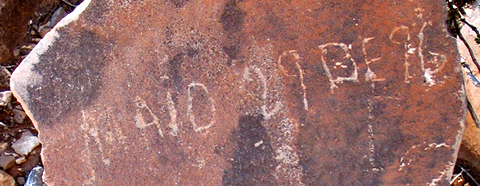
=====
Also at the site are many Petroglyphs. Here are a sampling:

Figure and horse. The horse may have a saddle.

The wide stride and the over-the-shoulder stick with the bag strongly suggests a soldier.

A beautiful Petroglyph, evidently a man cat. Behind it is a much smaller animal, which could be canine or feline:

Here we have a Petroglyph and a modern scratching:

The Petroglyph is made by tapping with a rock, the letters by scratching. You can see the clear difference in making technique here:
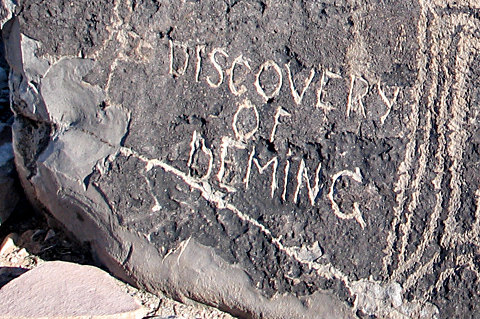
A mysterious petroglyph, partially buried:

Also in the area are many grinding (mortar) holes:
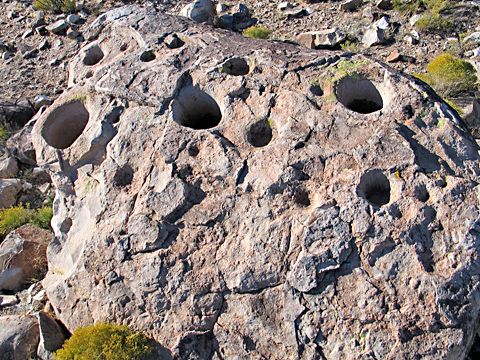
These holes were used by to grind various seeds into meal. The longer the period of use, the deeper the hole. One interpretation of the size variation is that different seeds ground better or easier in different sized holes. So many holes together might also be a sign that grinding was often a group activity.
Tuesday, April 28th, 2009
Mine House Spring – Hayner Mine
The structure known as the Mine House is located on the west slope of the Organ Mountains, not too far from the foot of the mountains. Not much is known about the house, except that it was used by the Hayner Mine while the mine was being worked. Some sources say it was a bunk house. The site was selected evidently because of the spring nearby. The date Sept 1930 is scratched in the concrete of the building, suggesting a possible date for its construction.
The road to the Mine House is very rough, as this Youtube video shows.
The site is fascinating to visit:







The Mine House is the usual starting point for hiking to the Hayner Mine, which is 6 tenths of a mile from the house. The trek is uphill and challenging, but not too difficult.
A short distance above the Mine House there appears to be a grave:

The view of the mountains from above the Mine House is spectacular (click image for a larger view):


The view of the Mesilla Valley (click for larger image):

Tags: Las Cruces, Organ Mountains, History, Hiking
Tuesday, January 20th, 2009
Hiking Dripping Springs – Part 3
Details on hiking to the springs in Dripping Springs Canyon are given here.
Details on the Van Patten Mining Camp are given here.
Boyd’s Sanitarium
Dr. Nathan E. Boyd came to Las Cruces some time before 1890. Although a medical doctor, he spent almost all his time on real estate and financial speculation. In 1892-3 he began promoting a dam across the Rio Grande River just west of Engle. In 1895 he obtained a permit from the US Government to build the dam.
Construction on the dam began, financed by English capital. However, he immediately ran into huge political opposition. Mexico lodged a formal protest, claiming that it would interfere with her water rights. Agricultural interests in the Mesilla Valley strongly turned against the plan when it became clear what Boyd intended to charge. The proposed fee was one half of any land irrigated by water from the dam. Other opponents used the issue of the Rio Grande River being a navigable body of water to tie up the project in the courts.
The battle lasted until 1903, when the project was finally defeated. But Boyd continued to be legally entangled in the fallout for another decade.
Nine years later, in 1912, construction began on the Elephant Butte Dam, which was located south of Boyd’s dam site. This project was only possible because of the battles Boyd fought. He lost those fights, but started the processes that led to their eventual settlement.
In 1905 Boyd founded the First National Bank of Las Cruces. A year later he was forced out of the company due to loans to himself. He then organized the Mesilla Valley Real Estate Company, which among other ventures, purchased and re-sold the old Shalam Colony site.
So, by the time that Boyd bought the Dripping Springs property in 1917, he was known for his grandiose ideas. He immediately announced a huge sanitarium would be built on the site. In the end, he build only a small sanitarium.
The ruins of the Boyd Sanitarium are south of the springs, up a short path:
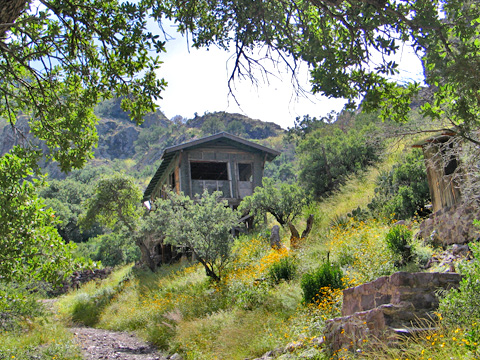
Here’s the dining area of the sanitarium, half of it built on stilts:



Here’s what the inside looks like, taken through the door. Entrance into the structure is forbidden, due to its fragile condition.

Here you can see what a gorgeous setting it is:
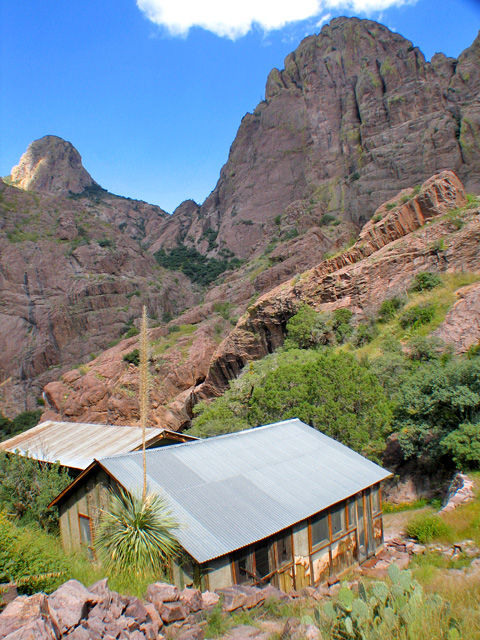
To one side and below the sanitarium is the operator’s house, or Boyd’s house, depending upon the account:

A close up of the house:

Again, entrance is forbidden.
Some time in the 1920s Dr. Boyd sold the property to Dr. T. C. Sexton and moved to Washington D. C. Does anyone know what happened to him after he left Las Cruces?
Related posts:
La Cueva – Hermit’s Cave
Hiking Dripping Springs – Part 1
Hiking Dripping Springs – Part 2
Dripping Springs – Green, Green, Green!
Tags: Las Cruces, Organ Mountains, Hiking, History, Dripping Springs, Chihuahuan Desert, Nathan E. Boyd
Tuesday, November 4th, 2008
Hiking Dripping Springs – Part 2
Details on hiking to the springs in Dripping Springs Canyon are given here.
Details on the Boyd Sanitarium are given here.
Van Patten Mining Camp
The ruins of the Van Patten Mining Camp are a short hike north of the springs. Construction of the Camp began about 1895 and was completed and advertising for business in 1897. The Camp sold itself as a vacation resort in the Organ mountains several thousand feet above the sultry southern New Mexico desert. The resort building was L-shaped. One two-story wing had 14 hotel rooms for customers, and the other wing a large dining hall, a dance hall, a roller skate rink, and living rooms for the operators.
A historical marker at the site provides a photo of what the Camp, also known as the Dripping Springs Resort, looked like in 1900.
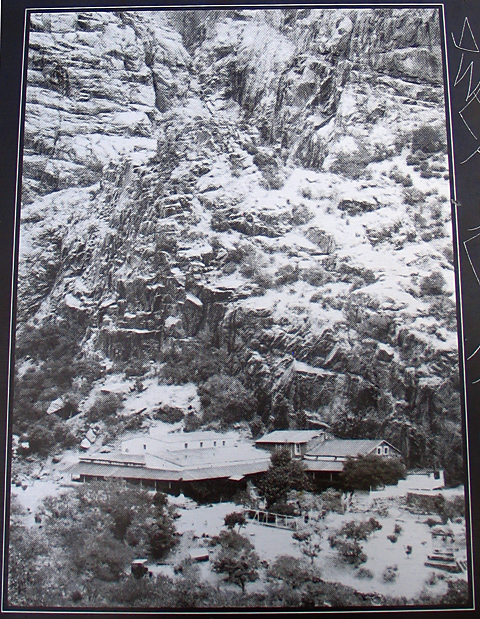
The marker provides a few historical details on Van Patten, but does not convey the extent of the accomplishments of this remarkable New Mexico pioneer.
Albert Eugene Van Patten was born November 10, 1839 in Oneida, New York, but many sources give a different, erroneous birth date.
In 1857 when John Butterfield was starting the Overland Mail Company, he hired Van Patten and his three older brothers to help set up the El Paso link of the stagecoach trail. They arrived in El Paso as part of the first Overland work crew on December 23, 1857. Van Patten did all kinds of work for the Company, including driving stages and serving as stationkeeper at the Picacho Station.
On February 9, 1860, Van Patten was the conductor of a stage coach ambushed by Apaches in Cooke’s Canyon on its way from Tucson to Mesilla. After a long standoff in which all of coach’s mules but one were killed, Van Patten, the driver, and the six passengers abandoned the coach and fortified themselves behind rock outcrops. They were rescued eventually by scouts of a merchant party which happened to hear shooting.
When the civil war started he joined the Confederates, even though he was born a Yankee. Following the war, he was a life-long Republican.
In 1865 he married Benita Madrid Vargas, a high ranking Piro Indian. This began a life-long commitment to Indian interests, and he was a major player in the Piros relocating to Tortugas and being granted title to that land by the State of New Mexico in 1914.
He served in many offices, including county sheriff from 1884 to 1888 and deputy U. S. Marshall from 1889 to 1896. He led the posse that tracked the murders of Colonel Albert Fountain and his son Henry, and was a major witness at the trial (the accused were acquitted). Although unable to serve, he helped organize the New Mexico contingent of Roosevelt’s Rough Riders.
In 1917 (not 1915 as given by the historical marker) he sold the Van Patten Mountain Camp to Dr. Nathan Boyd and entered a long period of financial difficulties. When he died on February 28, 1926, he was almost destitute.
The Ruins
The Camp Ruins are extensive, and make stunning photographs. This part of the original structure is in the best condition. Note how the two end windows in the eve match the windows in the old photo.


These ruins are of the other wing.

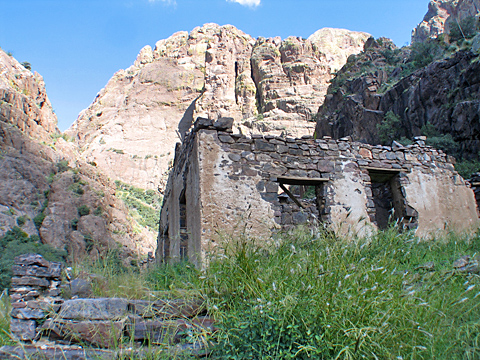





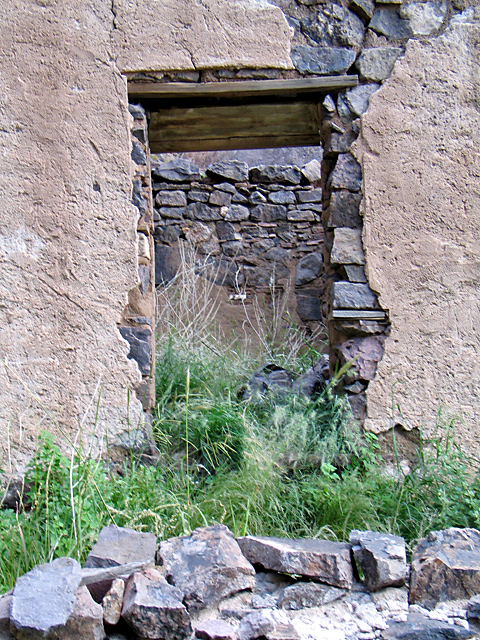
Picnic Area
Take your lunch, because there is a lovely, shaded picnic space next to the Camp ruins.

Related posts:
La Cueva – Hermit’s Cave
Hiking Dripping Springs – Part 1
Hiking Dripping Springs – Part 3
Dripping Springs – Green, Green, Green!
Sources:
Las Cruces New Mexico, 1849-1999, Gordon Owen, Red Sky Publishing Company, Inc, 1999.
Pioneers of the Mesilla Valley, Paxton P. Price, Yucca Tree Press, 1995
The Butterfield Trail in New Mexico, George Hackler, Yucca Enterprises, 2005
Tags: Las Cruces, Organ Mountains, Hiking, History, Dripping Springs, Chihuahuan Desert, Eugene Van Patten
Thursday, September 18th, 2008
Las Cruces Gets Talkies
On October 19, 1929, the Las Cruces newspaper announced the arrival of talkies:
Sound Pictures Coming
A matter of great interest to Las Cruces theatre goers is that tomorrow the Fox Rio Grande Theatre, one block west of Church street, will open up their sound projector system which they have been busily installing for the past week or so. From the character of pictures with sound which have been booked for the coming weeks it is quite apparent that Las Cruces is to have just as high grade entertainment in that line as the largest cities in the country. Las Cruces is to be congratulated upon this fact and it is comforting to know that with this beautiful playhouse, and the installation of this most adequate and modern sound projecting system which is the product of Western Electric and the best made; together with the management afforded by the great Fox West Coast Theatre chain which now owns the Rio Grande, Las Cruces folks will not have to go to El Paso nor anywhere else to see and hear the best shows produced. It is also a matter of satisfaction to Las Cruces people that manager W. L. Gullett is to remain in charge of the management of the Rio Grande.
Las Cruces Citizen, October 19, 1929
Here’s the story behind this highly welcomed event:
Some time in early October 1929, the Rio Grande Theatre was purchased by Fox West Coast Theatres, a distribution and theater ownership company begun in 1921 by William Fox.
William Fox is one of the pioneers – and early heroes – of movies. He got into the film showing business in 1904 by starting the Greater New York Film Rental Company. In 1909, he played an important role in breaking Thomas Edison’s film monopoly, the Motion Picture Patents Company.
In 1915, he founded the Fox Film Corporation to make films, his first film being A Fool There Was staring “sex vamp” Theda Bara.
Business was booming in 1929 and Fox, who always thought “gigantic” and had a “big” reputation for showmanship, decided to celebrate his “Silver Jubilee” of being in the film business with a massive national promotion. On October 12, 1929, he ran the following full-page ad in the Las Cruces Citizen newspaper:

is the History of the Motion Picture”
Time Magazine said this about his campaign.
Last week came the Silver Jubilee (25 years) of the Fox Theatres, announced by lavish two-page newspaper advertisements that told of gala performances, mysteriously adding: “Far more important than even the entertainment, will be a message from William Fox of vital concern to the future welfare of every patron of Fox theatres.
In 500 of the 1,100 Fox theatres throughout the U. S. audiences heard this message delivered through Fox Movietone. The birthday gift was advice that Fox patrons buy outright as many shares as they could afford of Fox Theatres Corp. operating and holding company for his gigantic chain. As special inducement they were told of plans for future expansion and the large earnings that were possible.
Expansions promised by Mr. Fox far outstripped the ordinary bounds of showmanship. He promised not only installation of his “grandeur” proscenium-filling screen, and cinema houses devoted to newsreels, but magnificently he offered one fourth of his fortune (which newsmen were permitted to estimate at $36,000,000) to develop visual-oral instruction in schools. “On the theory,” he said, “that one picture is the equivalent of eight words” and that words uttered by college presidents are more potent than those of ordinary teachers, Mr. Fox visualized the time when 15,000,000 or 20,000,000 school children will have school hours reduced from six to three per day by listening to a talkie “educator” instead of to a teacher….
Less convincing than his generosity was Cineman Fox’s foxiness. Offered in 1925, Fox Theatres stock has paid no dividends, has never responded to continued reports of expansion. In 1928 its earnings were $1.91 a share. Previous attempts to distribute the stock, mostly held by speculators, have been unsuccessful. Early this year a group of brokers ran the stock to 37-7/8, but before much was distributed it broke to 21-1/2. Last week it was strong around 28 on belief that the Fox Birthday plan, if successful, will reduce the floating supply.
Time Magazine, Oct. 21, 1929
The coming attractions advertisement that ran in conjunction with the Silver Jubilee announcement showed that the first talkie in Las Cruces was The Flying Fool, staring William Boyd. William Boyd later became famous as “Hopalong Cassidy.” The Flying Fool was followed by Geraldine, The Single Standard, and Diamond Master.

The Flying Fool is the story of a WWI pilot with that nickname who falls in love with his brother’s girlfriend. To settle who gets the girl, the brothers “fight it out” without guns in the air. After taking extraordinary risks, both brothers land safely and the girl decides she is in love with the “Flying Fool.”

Stock Market Crashes – October 24, 1929
The people who attended the Thursday showing of The Single Standard staring Greta Garbo probably enjoyed it. It’s impossible to say how many people in Las Cruces heard of or worried about the stock market crash that day. Certainly no one knew that people would later consider that event that day — Black Thursday — the beginning of The Great Depression.
On October 26 the Las Cruces Citizen published the advert for the next week’s pictures, clearly marked as talkies.

For the curious, here’s the advertisement for the last silent movies shown in Las Cruces, just prior the Rio Grande Theatre’s purchase by Fox.

See Also:
Screen With A Voice – A History of Moving Pictures in Las Cruces, New Mexico
Rio Grande Theatre
Rio Grande Theatre – More History
Tags: Las Cruces, Rio Grande Theatre, Theaters, History, Main Street
Saturday, September 13th, 2008
Rio Grande Theatre – More History
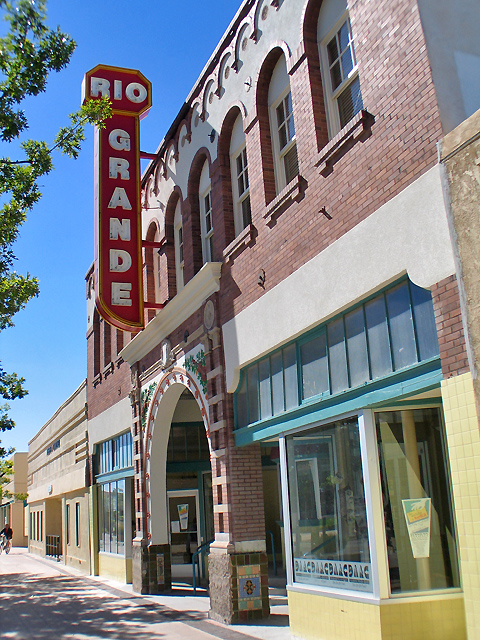
The Rio Grande Theatre opened on July 29, 1926. The official announcment to the public was made in the July 24 issue of the Las Cruces Citizen newspaper:
RIO GRANDE THEATER OPENS JULY 29
At last we are privileged to announce the definite opening date of the new Rio Grande Theatre built by Seale and Dyne and operated by the Central Theatres Corporation of Denver as Thursday July 29th with the powerful Sea Drama “Mare Nostrum” as created by the masterful director, Rex Ingram with Alice Terry and Antonio Moreno in the leading roles. Mr. Ingram has directed such notable successes as The Four Horsemen of the Apocalypse, and may others. Mare Nostrum is conceded to be one of the outstanding successes of the year and the management was indeed fortunate in securing an attraction of this caliber as an opening production.
A treat indeed is in store for those who have anxiously awaited the opening of this truly wonderful institution which is a great credit to the Southwest, the builders who have had the foresight to visualize the future in their enterprise and the operators for the confidence they have placed in the community in the manner they have equipped the theatre.
Replacing the old style painted scenery, the stage is to be hung and decorated in a lavish manner with velvet drapes and curtains as is the Auditorium proper. The foyer and aisles are carpeted in a rich red and the lightning [lighting] is as modern as has yet been installed in even the larger theatres in the cities.
A washed air cooling system maintains any desired temperature with its clean pure air as distributed scientifically throughout the house, the mammoth organ will be operated by Miss Elsie Dean Bristol who comes direct from one of the corporation’s Denver theatres, which assures all lovers of accurately played pictures a treat in store for them.
— Las Cruces Citizen, July 24, 1926
The first advertisement for the theatre was published in the same issue of the newspaper:

The movie selected for the opening was the silent movie Mare Nostrum, directed by Rex Ingram. The New York Times’ movie critic Mordaunt Hall had given the movie a mixed review on Feb 16, 1926. Even then, the movie critic’s basic stance of a haute attitude and a pseudo-intellectual tone is evident. Some quotes from that review:
“The German submarine and the Wilhelmstrasse spy system during the World War are the theme of Rex Ingram’s picturization of Blasco Ibanez’s “Mare Nostrum,” which was presented last night before an audience that appeared to be left slightly dazed by the weird delivery of the film. It is an effort that in the second half has its full quota of thrills, but in the end it reminds one of the Von Tirpitz edict—”Spurlos Versenkt!” The heroine and the hero have met their deaths and so have the villains; the comedian alone is left to drift back to his Spanish port aboard a flimsy raft.”
“Mr. Ingram goes about the unfolding of this narrative with a dislike of haste. He seems to tell you that you must gaze upon his story as he tells it or not at all, and therefore it is not until just before the first half has come to a close that interest in the picture is really awakened; that happens to be through a scene in which a stout German Frau Doktor of the German Secret Service, her faithful and beautiful aid, Freya Talberg, and a Spanish skipper, drink a toast to the Emperor Josef.”
“The first sequence dealing with the sinking of a British vessel by a submarine is graphically filmed. The Mediterranean is a tame stretch of blue to a wireless operator. He had just said “Hello” to his colleague aboard the Californian. Then one perceives the submersible sneaking after its prey, and subsequently the Californian receives her death blow in an explosion of spray and fire. Aboard the other vessel all is tranquil; then the wireless operator gets the S. O. S., but gradually the sinking ship is covered by water. The commander of the submarine pushes his cap back over his shorn head and checks off the British steamship as having been sunk.”
“Freya is arrested as a spy and taken from Marseilles to the St. Lazare prison, in Paris. In the course of usual motion picture events Freya would have been saved at the last minute. One awaits it in this film. She is taken to Vincennes in the early morning, and the soldiers line up. The buglers sound “Taps” after making a flourish with their brass instruments. Freya had made a petition to be shot in furs, feathers and expensive clothes; it was granted. She had walked proudly to the white stake against which she rests. Her hands had been tied with rope. An officer winces before the order is given to fire. When that order comes the rifles blaze and nothing more is seen of Freya until a weird idea or nebulous figures under the sea is portrayed at the end of the picture.”
“Alice Terry is fair, but unconvincing in the rôle of the German spy. She is too phlegmatic for the part. Antonio Moreno figures as the susceptible Ferragut. Mr. Moreno has plenty of character in his countenance, but he does seem to be a ready victim to a pair of blue eyes.”
“Aside from the effective photography in Spain, Italy and France and the dramatic sequences concerned with the submarine’s deadly work and the shooting of a woman spy, this production does not do justice to the talent of the man who made “The Four Horsemen of the Apocalypse” and “Scaramouche.” His last production, “The Arab,” was lovely but a slow story that did not boast of much in the way of drama.”

“Mare Nostrum” is Latin for “Our Sea.” Beginning in Roman times it referred to the Mediterranean Sea. During World War I, it was common shorthand for the fight for control of the Mediterranean between the two sides.
Probably no one in Las Cruces at the time read the New York Times’ review. The opening was a big success:
NEW THEATER HAS GRAND OPENING
W. L. Gullett, manager of the new Rio Grande Theater got off to a good start Thursday night when he opened this fine new playhouse because the house was packed and the play was up to expectations, and then some.
It is needless to say that he will continue to have full houses as it is Mr. Gullett’s intention to bring only the best plays.
M. B. Stevens, the popular realty man, made an address that took big. If “Mo” decides to throw his old chapeau into the political ring, the La Estella will get right behind his candidacy.
Las Cruces Citizen, July 31, 1926
As was standard in those days, the Rio Grande Theatre changed its movies every week. Here’s the showing for the second week, July 31, 1926:

Here’s the newspaper ad for week three, Aug 7, 1926:

See Also:
Screen With A Voice – A History of Moving Pictures in Las Cruces, New Mexico
HANG ‘EM HIGH
For more photos of the Rio Grande Theatre see this prior post.
Las Cruces Gets Talkies.
Tags: Las Cruces, Rio Grande Theatre, Theaters, History, Main Street

